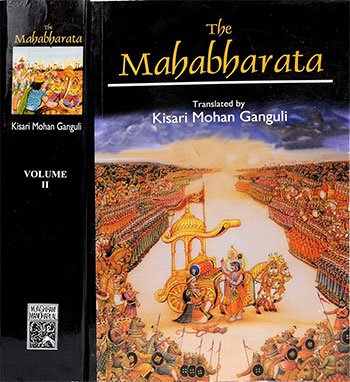Section XLIV - Understanding Brahman through Brahmacarya Practice and Knowledge
Book index: Mahabharata (English)
This page contains a summary of the Mahabharata Section XLIV including examples of moral lessons in daily life. The Maha-Bharata is one of the largest epics ever written containing roughly 100,000 Sanskrit verses. It deals with the legendary history of ancient India and contains a large number of interwoven tales.
Short summary of the chapter:
Sanat-sujata, a wise Rishi, engages in a conversation with King Dhritarashtra about the attainment of Brahman and the origin of the universe. He explains that the knowledge of Brahman is attained through Brahmacarya, which involves restraining the senses and aligning the will with the pure intellect. The path to attaining Brahman involves practicing austerities, respecting and serving the preceptor, and cultivating righteousness.
Sanat-sujata emphasizes the importance of following the principles of Brahmacarya, which include showing respect and gratitude towards the preceptor, striving for purity in thought and action, and dedicating all earnings to the preceptor. Through practicing these virtues and studying under the guidance of a preceptor, a disciple can progress on the path towards attaining knowledge of Brahman. The disciple's devotion, humility, and dedication play a crucial role in the process of acquiring wisdom and enlightenment.
The Rishi explains that Brahmacarya is the key to unlocking the knowledge of Brahman, which ultimately leads to immortality. By purifying the body, mind, and soul through dedicated practice and adherence to the teachings of the preceptor, one can transcend the limitations of the physical world and achieve union with the Supreme Soul. The virtues of Brahmacarya enable the seeker to thrive in this world, gain spiritual insight, and cultivate a sense of detachment from worldly desires.
Sanat-sujata elucidates that Brahman, the ultimate reality, transcends all physical forms and colors. It is beyond the grasp of the senses and intellect, existing as the foundation of the universe and the source of all creation. The true form of Brahman cannot be perceived through external manifestations or objects; it is subtle yet all-pervading, unchanging yet encompassing all duality. Those who attain knowledge of Brahman through pure devotion and self-discipline experience liberation from the cycles of birth and death.
In conclusion, the dialogue between Sanat-sujata and King Dhritarashtra highlights the significance of pursuing spiritual knowledge and practicing virtues such as gratitude, humility, and dedication on the path towards attaining Brahman. Through the discipline of Brahmacarya, one can purify the mind and body, cultivate inner peace and wisdom, and ultimately realize the eternal nature of Brahman. The journey towards spiritual enlightenment requires sincerity, perseverance, and a deep understanding of the true nature of the self and the universe.
Full English translation:
This page is merely a summary which is automatically generated. If you are looking for authentic sources such as the Sanskrit text or the Full English translation of Mahabharata Section XLIV - Understanding Brahman through Brahmacarya Practice and Knowledge, have a look at the following articles:
Section XLIV, online text
English translation by Kisari Mohan Ganguli.
Read this and other chapters online.
Mahabharata (English Summary)
by Kisari Mohan Ganguli | ISBN-10: 8121505933
Buy the latest edition:
FAQ of Mahabharata, Section XLIV:
What is the nature of the knowledge of Brahman?
The knowledge of Brahman requires restraining the senses and merging the will in intellect, attained through Brahmacarya. It leads to immortality and is manifested through pure intellect.
How is Brahmacarya practiced to attain knowledge of Brahman?
Brahmacarya involves showing respect to the preceptor, studying diligently, and following the preceptor's teachings. It requires selfless service, gratitude, and dedication to the preceptor's instructions, along with purity of mind and actions.
What are the twelve virtues that constitute Brahmacarya?
The twelve virtues that constitute Brahmacarya include obedience, humility, gratitude, selflessness, sacrifice, perseverance, respect, devotion, purity, diligence, generosity, and understanding.
How is the true form and color of Brahman described?
The true form and color of Brahman are beyond human perception, not resembling any worldly elements. It is all-pervading, unchangeable, subtle, and the basis of the universe. Brahman is described as vast, delightful, and free from duality.
Daily life: Understanding Brahman through Brahmacarya Practice and Knowledge:
To integrate the profound teachings of the discourse between Dhritarashtra and Sanat-sujata into everyday life, one begins by recognizing the essence of Brahman, the ultimate reality, as something beyond worldly desires and distinct from the perceptions driven by sensory indulgence. Embracing Brahmacarya, or living a life of discipline and virtue, is essential. This doesn't merely signify celibacy but encompasses a broader spectrum of self-restraint, moral conduct, and dedication to spiritual growth, which cultivates the mind for deeper understanding.
Daily practice involves engaging in actions that align with higher principles devoid of selfish motives, fostering a mindset that sees beyond the temporary nature of material existence. It means dedicating oneself to continuous learning and self-improvement under the guidance of wisdom, be it from teachers, scriptures, or introspection. Such a lifestyle demands respect and honor towards those who impart knowledge and wisdom, recognizing their role in helping us transcend our limitations.
The path outlined suggests that immersion in disciplined learning and practice purifies the individual, gradually revealing the knowledge of Brahman within one's consciousness. It is a journey of patience, where one’s actions are devoted to the pursuit of ultimate truth, rather than immediate rewards. This transformation leads to a state of being that is in harmony with the cosmos, where desires and ego diminish, making way for a life of contentment and service.
Implementing these teachings requires a resilient commitment to spiritual values, meditation, and ethical living, seeing every moment as an opportunity to move closer to the profound peace and understanding that Brahman represents. Through such a dedicated approach, one not only transcends the cycle of birth and death but also realizes the eternal nature of the soul, embodying the virtues that lead to blissful liberation.
